By JD at Cherokee West Enterprises
So if there was ever a blog to read about shipping containers, (aside from this one of course) I would have to say it would be TincanCabin. I have read many blogs in my lifetime, and quite a few over the last few months that deal with shipping and cargo containers and their uses, one category that has always interested me is containerized housing, but TincanCabin.com is by far (in my opinion) one of the most well put together, most informative blogs regarding creative uses of containers.
The Shack Attack
 Meet Steve. Steve had a hunting shack. It was situated somewhere out in a very impressive looking clearing on a lovely patch of farmland in Wisconsin. Now, judging by the picture, I would be more than happy with this view, but then again I don’t have to worry about all of the things that Steve has to worry about, because I don’t have a hunting shack in an impressive looking clearing on a lovely patch of farmland in Wisconsin. Also, I can’t really see the shack from here. Steve had been thinking of putting something new up out there for quite awhile, and while he had many reasons for this, he unfortunately had just as many reasons to go about his normal life without a new hunting shack. However, the final straw fell on the stack one winter when the shack was broken into and caught fire. Apparently the basic concept of fire was not understood, and the unwelcome guests decided to hang an open flame from an old, wooden ceiling and of course it caught fire. Luckily Steve was prepared (even in his own absence), and had a fire extinguisher in the shack, and the trespassers saw fit to put the fire out before they left. How kind.
Meet Steve. Steve had a hunting shack. It was situated somewhere out in a very impressive looking clearing on a lovely patch of farmland in Wisconsin. Now, judging by the picture, I would be more than happy with this view, but then again I don’t have to worry about all of the things that Steve has to worry about, because I don’t have a hunting shack in an impressive looking clearing on a lovely patch of farmland in Wisconsin. Also, I can’t really see the shack from here. Steve had been thinking of putting something new up out there for quite awhile, and while he had many reasons for this, he unfortunately had just as many reasons to go about his normal life without a new hunting shack. However, the final straw fell on the stack one winter when the shack was broken into and caught fire. Apparently the basic concept of fire was not understood, and the unwelcome guests decided to hang an open flame from an old, wooden ceiling and of course it caught fire. Luckily Steve was prepared (even in his own absence), and had a fire extinguisher in the shack, and the trespassers saw fit to put the fire out before they left. How kind.
Floating ‘Round My Tin Can
Upon discovering his newly toasted roof, Steve decided it was time to spend some time working on his shack in his impressive looking clearing on a lovely patch of farmland in Wisconsin. First, Steve needed some inspiration, so he turned to a higher power, a higher power that quite a few people seem to turn in their hour of need in this modern age, the Google search bar. I have no idea what Steve actually searched for, but I can imagine his queries included words like secure, cheap (or low-cost) housing ideas, cabin ideas and maybe fireproof ceiling. I’m sure there were plenty more, but Steve eventually ended up coming across the idea of shipping containerized housing, and building his cabin from shipping containers. He doesn’t go into a whole lot of detail about his investigation process, or the thought behind it, but he does mention the one thing that intrigued him the most about the idea, big metal doors. He relished the idea of big, heavy, secure, fire-resistant doors that could be closed and locked when he was away to protect against the weather, trespassers and of course, anyone who would hang a lantern from the ceiling. So once Steve had decided which way to go, he entered the planning phase. He tested (by hand sketching) many different ideas and configurations, 3 containers, 4 containers, one story, two story etc.. He eventually migrated the ones he liked into a handy program called Google SketchUp (which now seems to be called Trimble SketchUp) and was able to actualize his plans into 3D models that proved very useful to his design process. I don’t have much experience in this area, so if you would like to read more about this, click here. Steve is a great writer, especially when it comes to the technical side of things, and as you can see from his comments section, he is also extremely helpful to those who are interested. I have never been very talented when it comes to art, so the idea of creating a model of something and being able to manipulate every detail, all the way down to the windows and furniture, is extremely fascinating to me, but also quite intimidating. So until I end up in this phase of building my containerized house, Ill leave it to Steve. (Even then, I still might seek help from him.) So the next step in Steve’s process is to purchase the containers. Steve goes into great detail about the factors in his decision of which size of container he chose, and why here. I am proud to say that he bought his containers from Cherokee West Enterprises, and even mentions that we had the lowest prices at the time. Next, here is a quick rundown of things to consider when purchasing a container for housing purposes.
New or Used:
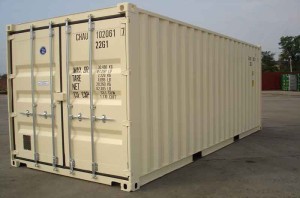 This decision should be made carefully and options should be weighed depending on your budget and the needs of your project. Steve opted for what are known as “one trip containers.” They are new containers that have been built, then used for one shipment to a port near you, and are then emptied and transferred to your specified destination. This is probably the most economical option if you are considering a new container, by limiting the number of trips you also have the advantage of knowing that your floors and walls have little or no exposure to anything strange or toxic. If you have decided a new, or one trip container isn’t right for you, then you’re looking at used containers. First, consider what these containers go through in their normal pattern of use. They are moved with machinery often, spend quite a bit of time at sea, and then are stored in a yard and may or may not be moved again for a long period of time. Things to check for when considering a used container are dent and dings (potential holes), rust, and the condition of the floor. Don’t get me wrong, a few dents and a rusty spot don’t necessarily mean that your container is useless, these things are designed to take a beating and still protect the cargo inside. It’s just important to know the difference between cosmetic damage, and damage that would actually affect the usability of the container. A good way to inspect a used container is to step inside and have someone (preferably someone who’s not mad at you) close the door and “lock you in.” Then just look around, if there are any spots where the light comes through, these are spots that have either rusted through, or been punctured in some way. Use your best judgement here, as this is not a foolproof method of evaluating a container, but it gives your basic idea of the condition of the container. Another thing to keep in mind when considering used containers is inventory limitations, there is no “used container factory,” so if you aren’t happy with the color, or a few dents and dings you might have to slightly alter your plans to accommodate what is available near you.
This decision should be made carefully and options should be weighed depending on your budget and the needs of your project. Steve opted for what are known as “one trip containers.” They are new containers that have been built, then used for one shipment to a port near you, and are then emptied and transferred to your specified destination. This is probably the most economical option if you are considering a new container, by limiting the number of trips you also have the advantage of knowing that your floors and walls have little or no exposure to anything strange or toxic. If you have decided a new, or one trip container isn’t right for you, then you’re looking at used containers. First, consider what these containers go through in their normal pattern of use. They are moved with machinery often, spend quite a bit of time at sea, and then are stored in a yard and may or may not be moved again for a long period of time. Things to check for when considering a used container are dent and dings (potential holes), rust, and the condition of the floor. Don’t get me wrong, a few dents and a rusty spot don’t necessarily mean that your container is useless, these things are designed to take a beating and still protect the cargo inside. It’s just important to know the difference between cosmetic damage, and damage that would actually affect the usability of the container. A good way to inspect a used container is to step inside and have someone (preferably someone who’s not mad at you) close the door and “lock you in.” Then just look around, if there are any spots where the light comes through, these are spots that have either rusted through, or been punctured in some way. Use your best judgement here, as this is not a foolproof method of evaluating a container, but it gives your basic idea of the condition of the container. Another thing to keep in mind when considering used containers is inventory limitations, there is no “used container factory,” so if you aren’t happy with the color, or a few dents and dings you might have to slightly alter your plans to accommodate what is available near you.
Size:
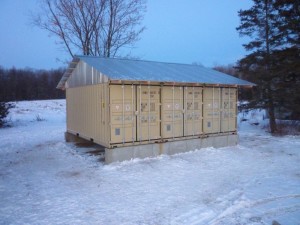 Although there are quite a few different sizes and configurations of shipping containers to choose from: 20′, 40′, 48′… Single door, double door, Hi-cube etc… The ones you see the most often, whether it be riding on the back of a big-rig or train, or stacked in giant mountains at ports all around the world, will be your “run of the mill” 20′ and 40′ general purpose containers. These are 8′ wide, 20′ or 40′ long and 8’6″ high (external dimensions). Steve went with 20′ containers and he explains why here in his article about buying the containers. By the way, if you’ve been clicking the links so far you’ll notice that I’m using the pictures from Steve’s blog (Thanks Steve!) It’s nice to see our containers in action. Steve’s situation called for 20′ containers with standard height and door configuration, but yours may call for something different. For instance, if you want a higher ceiling, a hi-cube is for you. Or perhaps you want both ends to open, this would call for a double door. There are many different sizes and specifications available, and if you’re having trouble deciding what is right for your project feel free to contact us any time, or head on over to TincanCabin.com and Steve might have already answered your question.
Although there are quite a few different sizes and configurations of shipping containers to choose from: 20′, 40′, 48′… Single door, double door, Hi-cube etc… The ones you see the most often, whether it be riding on the back of a big-rig or train, or stacked in giant mountains at ports all around the world, will be your “run of the mill” 20′ and 40′ general purpose containers. These are 8′ wide, 20′ or 40′ long and 8’6″ high (external dimensions). Steve went with 20′ containers and he explains why here in his article about buying the containers. By the way, if you’ve been clicking the links so far you’ll notice that I’m using the pictures from Steve’s blog (Thanks Steve!) It’s nice to see our containers in action. Steve’s situation called for 20′ containers with standard height and door configuration, but yours may call for something different. For instance, if you want a higher ceiling, a hi-cube is for you. Or perhaps you want both ends to open, this would call for a double door. There are many different sizes and specifications available, and if you’re having trouble deciding what is right for your project feel free to contact us any time, or head on over to TincanCabin.com and Steve might have already answered your question.
Manufacturer:
You want to try to make sure that all of your containers are from the same manufacturer. This may sound a bit picky, but if I recall correctly, Steve also mentions this a time or two. Even though there are some fairly strict standards when it comes to intermodal container manufacturing, there are still some subtle differences in containers from company to company. It may simply be a slightly different thickness of metal somewhere, or just the fact that a certain spot is put together in a different order, but you will find that even though these things are made to be universal, when it comes time to start welding them together, you may encounter some issues that might not have come up were all the containers from the same factory.
Modifications and Options:
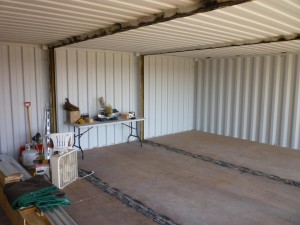 Consider simple things like whether or not you plan to use the existing doors on the containers. If you do, chances are you’ll want a container with a lockbox, which adds a little box on the outside of the door that you may place a lock into and prevents the lock from being tampered with or cut with bolt cutters. Handle height is another consideration, Cherokee West Enterprises sells containers with “waist high” handles, these are handles located about halfway up the height of the door and are much easier to operate than their lower counterparts. As far as other modifications go, there are many things that can be done with a container by professionals at the depot before passing it on to the buyer. Many companies offer lighting packages, HVAC kits, window options and more. Steve brings up a big point of concern in his blog when he begins investigating The Floor Dilemma. The issue here is simple to describe, but not necessarily as simple to take care of. The wooden floors in the containers are chemically treated at the factory, mostly to protect against foreign insects hitchhiking their way across the globe, there very well might be some other reasons, but this is reason enough to accept it as a “necessary evil.” So what are your options when it comes to the floor? If you read Steve’s blog page here, he really did his homework. He ended up sealing the floors with a very specific type of epoxy and then installing a sub-floor over the top. This provided an acceptable solution to his chemical problem, as well as an aesthetically pleasing alternative to staring at treated plywood all day. Since reading about this I have been doing some investigating of my own into these issues, And have come up with a few possible alternatives. The first alternative comes directly from the factory, when ordering a new container you have the option to substitute the original hardwood floor with a bamboo floor. While this may not be an instant fix for the chemical treatment problem, it is definitely a considered green alternative to the tropical wood generally used in shipping container floors. This second alternative is to have the container modified to depot, and while this idea has not been fully explored, Cherokee west is currently in the process of coming up with an effective, economical solution to the container flooring problem. Feel free to contact us for more information regarding this subject, and you can definitely expect another blog post in the future with further information on what we discover.
Consider simple things like whether or not you plan to use the existing doors on the containers. If you do, chances are you’ll want a container with a lockbox, which adds a little box on the outside of the door that you may place a lock into and prevents the lock from being tampered with or cut with bolt cutters. Handle height is another consideration, Cherokee West Enterprises sells containers with “waist high” handles, these are handles located about halfway up the height of the door and are much easier to operate than their lower counterparts. As far as other modifications go, there are many things that can be done with a container by professionals at the depot before passing it on to the buyer. Many companies offer lighting packages, HVAC kits, window options and more. Steve brings up a big point of concern in his blog when he begins investigating The Floor Dilemma. The issue here is simple to describe, but not necessarily as simple to take care of. The wooden floors in the containers are chemically treated at the factory, mostly to protect against foreign insects hitchhiking their way across the globe, there very well might be some other reasons, but this is reason enough to accept it as a “necessary evil.” So what are your options when it comes to the floor? If you read Steve’s blog page here, he really did his homework. He ended up sealing the floors with a very specific type of epoxy and then installing a sub-floor over the top. This provided an acceptable solution to his chemical problem, as well as an aesthetically pleasing alternative to staring at treated plywood all day. Since reading about this I have been doing some investigating of my own into these issues, And have come up with a few possible alternatives. The first alternative comes directly from the factory, when ordering a new container you have the option to substitute the original hardwood floor with a bamboo floor. While this may not be an instant fix for the chemical treatment problem, it is definitely a considered green alternative to the tropical wood generally used in shipping container floors. This second alternative is to have the container modified to depot, and while this idea has not been fully explored, Cherokee west is currently in the process of coming up with an effective, economical solution to the container flooring problem. Feel free to contact us for more information regarding this subject, and you can definitely expect another blog post in the future with further information on what we discover.
Getting to work:
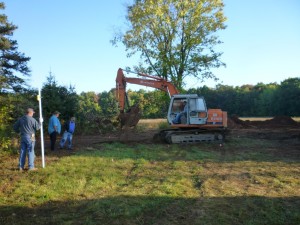 From here on, I have much less to say about the process, not because it’s any less important, or any less interesting (quite to contrary, this is where things really start to get good,) but simply because I have less knowledge of these areas and Steve has written so much, and so well on the subject that there just really isn’t that much to add without specific questions to answer. I have also chosen to begin to sort of wind down here in an effort to keep this post at a decent length. So… On we go…
From here on, I have much less to say about the process, not because it’s any less important, or any less interesting (quite to contrary, this is where things really start to get good,) but simply because I have less knowledge of these areas and Steve has written so much, and so well on the subject that there just really isn’t that much to add without specific questions to answer. I have also chosen to begin to sort of wind down here in an effort to keep this post at a decent length. So… On we go…
Consulting a Professional:
Depending on your day job, and your general skill set, this is the point in the process where anyone who has any experience in this process would recommend you consult a professional. This person may be an engineer, an architect, or perhaps just someone with a great deal of experience in construction, but when it comes to parts of the process such as the foundation, or anything that has to do with the structural integrity of the shipping container, or the shelter which it is to provide, it is always best to consult a professional. Of course all of this depends on the intricacy of your project, for example if you’re simply placing one 40′ container onto an existing concrete foundation next to your house, you’re probably not going to need a lot of help. This changes if you’re planning to join together five containers in a multi-level structure, you are definitely going to need some advice from someone who has experience. I want to be very clear, it is very important to be safe and precise when modifying containers, especially when it involves making modifications to any parts of the container that will affect structural integrity. If your structure is poorly planned or executed, it could not only potentially be a huge waste of money, but also a risk to your health and personal safety (especially when it comes to building underground!!) If you’re stuck, and don’t think you can find someone to help give us a shout (just use the comments box at the bottom of the page) and we will do our best to put you in touch with someone who can help you complete your project safely and protect your investment.
The Rest of The Construction:
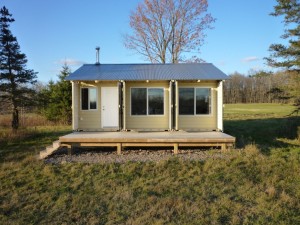 From that point on, Steve walks you through the entire construction of his Tin Can Cabin in such a detailed manner that it could almost be considered an instructional guide on how to build yourself a cabin from shipping containers. In fact, he has come close to an instruction manual here. Steve covers every part of the process in great detail, and judging by the comments section of each article he is almost always there to answer questions (I couldn’t find a single post without a response, when one was required.) His posts are very descriptive, and frequently feature pictures of his progress, his attention to detail is extremely commendable, and it is apparent that he has spent a lot of time researching every aspect of container based housing related to his project. You can go to his site (which he still currently updates) and follow his progress at www.tincancabin.com.
From that point on, Steve walks you through the entire construction of his Tin Can Cabin in such a detailed manner that it could almost be considered an instructional guide on how to build yourself a cabin from shipping containers. In fact, he has come close to an instruction manual here. Steve covers every part of the process in great detail, and judging by the comments section of each article he is almost always there to answer questions (I couldn’t find a single post without a response, when one was required.) His posts are very descriptive, and frequently feature pictures of his progress, his attention to detail is extremely commendable, and it is apparent that he has spent a lot of time researching every aspect of container based housing related to his project. You can go to his site (which he still currently updates) and follow his progress at www.tincancabin.com.
Cherokee West is your outlet for new and used shipping containers, connex boxes and metal storage containers. Our containers are guaranteed to be the highest quality on the market, with customer service to match. Built to stringent industry specifications, our cargo and shipping containers are theft and weather resistant, and can be modified to meet your individual needs.









1 comments
One thing to remember. There is no such thing as a “new” container. If you are buying one from an overseas manufacturer it has to make at least one trip across the salty pacific. A once shipped container is just as “new” as one billed that way.